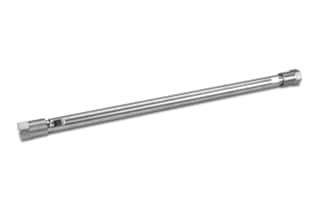
Waters Ultrahydrogel Columns contain a sophisticated aqueous-compatible gel column for analytical and preparative separations of water-soluble polymers. The gel is a cross-linked hydroxylated polymer and contains some residual carboxyl functionality. Ultrahydrogel DP contains some residual amine functionality. Compounds normally characterized include oligomers and biological substances such as polysaccharides, nucleic acids, proteins, and peptides.
|
Chemistry |
SEC |
|
Separation Mode |
Gel Filtration (aqueous) |
|
Particle Substrate |
Polymer |
|
pH Range Min |
2 pH |
|
pH Range Max |
12 pH |
|
Temperature Limits |
10 - 80C |
|
Molecular Weight Range Min |
100 |
|
Molecular Weight Range Max |
5000 |
|
Particle Shape |
Spherical |
|
Particle Size |
6 µm |
|
Endfitting Type |
Waters |
|
Pore Size |
120 Å |
|
Format |
Column |
|
Packing Solvent |
Water |
|
System |
HPLC |
|
Technique |
SEC |
|
USP Classification |
L25 |
|
Inner Diameter |
7.8 mm |
|
Length |
300 mm |
|
UNSPSC |
41115709 |
|
Application |
Gel Filtration |
|
Brand |
Ultrahydrogel |
|
Product Type |
Columns |
|
Units per Package |
1 pk |
Ultrahydrogel Column, 120Å, 6 µm, 7.8 mm X 300 mm, 100 - 5K, 1/pk
Waters" Ultrahydrogel Columns are packed with hydroxylated polymethacrylate-based gel, making them the ideal lab equipment for analysis of aqueous-soluble samples, including oligomers, oligosaccharides, polysaccharides, as well as cationic, anionic, and amphoteric polymers. With measurements of 7.8 x 300 mm, these columns are high resolution and offer a number of advantages when compared to conventional aqueous SEC columns. Able to work across a wide pH range of 2-12, Ultrahydrogel Column, 250Å, 6 µm, 7.8 mm X 300 mm, 1K - 80K, 1/pk are compatible with high concentrations of organic solvent- up to 20% organic, or 50% organic if the mobile phase is introduced by a gradient.
Achieve greater flexibility for the mobile phase with minimal non-size-exclusion effects with the sophisticated aqueous-compatible gel columns, usable in both analytical and preparative separations of water=soluble polymers. With a gel that is a cross-linked hydroxylated polymer, Ultrahydrogel contains some residual carboxyl functionality and some residual amine functionality. Compounds normally characterized include oligomers and biological substances like polysaccharides, nucleic acids, proteins, and peptides, with a temperature range of 10 C to 80 C. Ultrahydrogel Columns are physically and chemically stable in ordinary water-soluble organic solvent mixtures.
Enjoy Waters" innovations in instrumentation, packing materials, and technology, which have led to the advanced GPC and SEC analysis made possible by Ultrahydrogel Columns, allowing for size-exclusion techniques to be available outside of just polymer analysis. As a market leader in GPC analysis, Waters" products are manufactured under strict ISO, FDA, and cGMP guidelines across all chromatographic instrumentation and consumables.
"Ultrahydrogel 120 Column, 120 Å, 6 µm, 7.8 mm x 300 mm, 100 - 5K, 1/pk
1.What type of chromatography is the Ultrahydrogel 120 Column designed for?
The Ultrahydrogel 120 Column is specifically designed for size exclusion chromatography (SEC), a widely used technique for separating molecules based on their size and shape. SEC, also known as gel filtration, allows for the effective separation of different molecular species without any interaction with the column material itself, as separation is purely based on the physical size of the analytes. The Ultrahydrogel 120 Column provides reliable and reproducible results in various industries, including pharmaceuticals, biochemistry, and polymer sciences.
2.What is the molecular weight range of the Ultrahydrogel 120 Column?
The Ultrahydrogel 120 Column has a molecular weight range of 100 to 5,000 Da, meaning it is capable of effectively separating molecules that fall within this range. This makes it particularly well-suited for the analysis of smaller biomolecules, peptides, and synthetic polymers.
3.What is the particle size and pore size of the Ultrahydrogel 120 Column?
The Ultrahydrogel 120 Column is designed with a particle size of 6 µm and a pore size of 120 Å. These specifications are critical for ensuring the column's separation efficiency. The 6 µm particle size helps provide a balance between resolution and flow rate, while the 120 Å pore size is well-suited for separating smaller molecules.
4. What are the recommended mobile phases for the Ultrahydrogel 120 Column?
The Ultrahydrogel 120 Column is typically used with aqueous mobile phases, which are compatible with the hydrophilic nature of the column's matrix. Common mobile phases include phosphate buffers, acetate buffers, and other aqueous solutions, chosen based on the analytes and the separation conditions needed. Aqueous mobile phases ensure optimal separation while preserving the integrity of the sample, making the column suitable for the analysis of water-soluble polymers, proteins, and other hydrophilic molecules. The choice of buffer and pH can be fine-tuned depending on the specific characteristics of the analytes being separated.
What Is GPC?
GPC or gel permeation chromatography is a form of SEC (size exclusion chromatography), in which analytes are separated on the basis of size, usually in organic solvents. Often this technique is used for the analysis of polymers. Since its creation in 1964, Waters has created the proprietary GPC column technology needed to carry out this process. GPC works by separating based on the size (or hydrodynamic volume) of the analytes; this is different than other separation techniques which depend upon chemical or physical interactions to separate the analytes. The separation occurs via the use of porous beads packed into a column. GPC is often used to determine the relative molecular weight of polymer samples in addition to the distribution of molecular weight. It is measuring the molecular volume and shape function as defined by intrinsic viscosity.